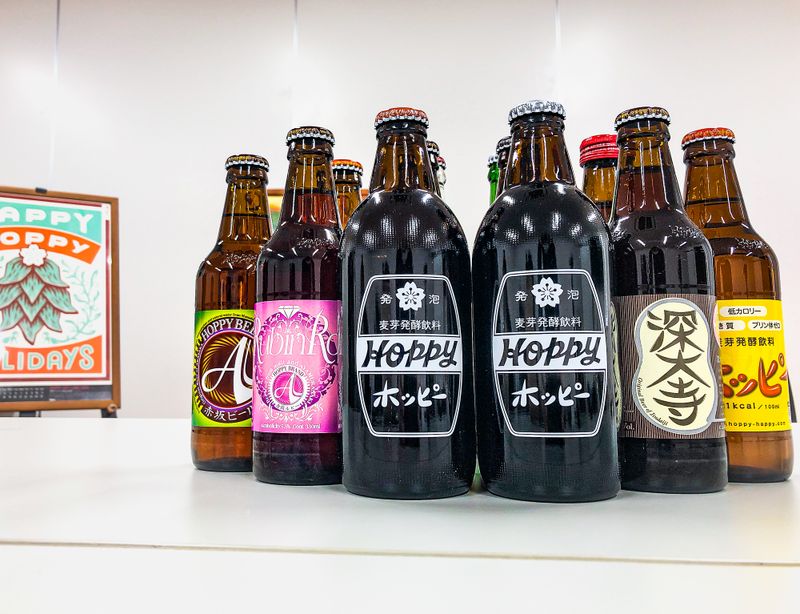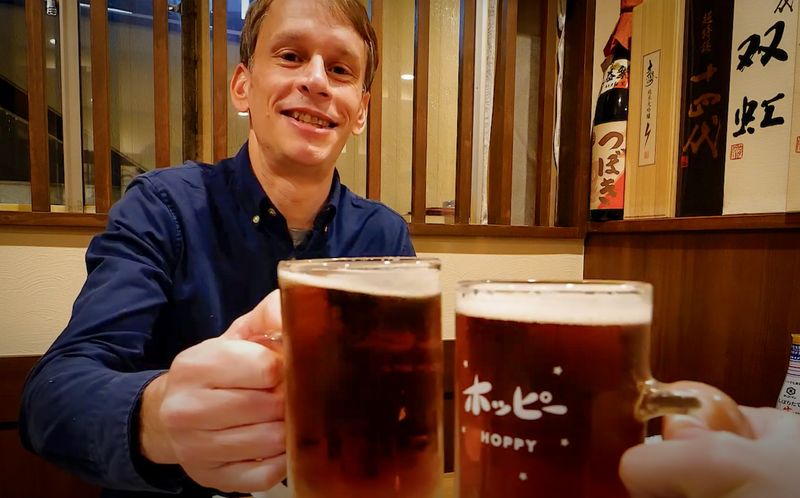Mar 31, 2023
Hoppy beverage serves up authentic taste of Chofu

A commitment to authenticity and the use of natural products persuaded the makers of the mixer drink Hoppy to set up production in the city of Chofu, a decision which has served them well as the beverage approaches its 75th anniversary this year.
Often described as “beer like,” at around 0.8 percent alcohol, the low-alcohol mixer Hoppy is brewed from malt and hops - a clue given in the name - and typically has been associated as a mixer for shochu distilled spirits.
Makers Hoppy Beverage shifted production of the drink from central Tokyo to a facility in Chofu in 1970. In its early days Hoppy Beverage actually produced the carbonated soft drink known as “ramune,” but a boom in the popularity of non-alcoholic beer during the early 20th century saw the company’s founder, Hide Ishiwatari, enter the market.
Ishiwatari was initially reluctant to go into the production of non-alcoholic beer which, with supplies scarce, was typically not made from brewing and fermentation but was a so-called imitation created from mixing bittering agents and foaming essence in water.
“Ishiwatari was invited to try and develop non-alcoholic beer but he refused at first. He said he would only be interested if it was genuine and that there would be no point unless it was a product he could sell to customers with the confidence that they could consume it with peace of mind,” said Sakiko Oishi, a PR representative from Hoppy Beverage.
“This was the founder's foresight, and we believe that our company's history would probably not have lasted 117 years if he had been driven by short-term profits and dabbled in fake non-alcoholic beer,” she said.
From a base in Nagano Prefecture, however, Ishiwatari was able to gain access to the region’s hops and so began the development of an authentic non-alcoholic beverage.
After the war, Ishiwatari moved production to Tokyo’s Akasaka district from where Hoppy first hit the shelves in 1948. Popularity of the drink soared and Hoppy Beverage eventually shifted production to its current location, near the Tama River in Chofu.
“In choosing the location, we wanted to stick to our company's founding principles - a commitment to authenticity and the use of natural products. Chofu is blessed with an abundance of water, which is also behind the city’s famous Jindaiji soba noodles,” Oishi said.
Approaching Hoppy's 75th anniversary, the principles of authenticity and natural products behind the drink haven’t changed but the image and the consumers have diversified under the leadership of current president, and granddaughter of Hoppy Beverage founder, Mina Ishiwatari.
Today, of the hundreds of thousands of bottles of Hoppy that come out of Chofu each day an increasing number of them are being consumed in creative ways often by a health-conscious and socially-conscious consumer.
With Hoppy being low in not only alcohol but also calories and carbohydrates some people simply enjoy the drink as it is, or “just style.”
“Hoppy is best known as a mixer for shochu but in recent years people are finding new ways to enjoy it. By mixing it with things like gin, vodka, and umeshu, people can enjoy a variety of drinks depending on their taste,” Oishi said.
“If you have 100 people, you could have 100 different ways to enjoy Hoppy.”
The message from the makers is one and the same when it comes to the glass bottles though - recycle them.
Amid all the new options and ideas, sometimes you can’t beat the old favorites. So it was that in an izakaya near Chofu’s Keio-Tamagawa station team City-Cost made easy work of a first-Hoppy-of-the-evening served in the classic sanrei style.
Sanrei, or “triple chilled,” refers to the Hoppy, the shochu, and the glass all brought to the table chilled. Very chilled. No ice though. Ratios between Hoppy and shochu, however, may vary depending on the tastes of the server (although 5:1 is considered standard).

The title of the video for which the purpose of this article is to introduce will likely be something about getting a taste of Chofu through the locally-produced Hoppy. So now then, we are perhaps duty bound to describe what Hoppy does taste like, and by extension Chofu!
In the cozy confines of a warm izakaya on a frigid February evening Hoppy was the taste of a job well done, or at least the taste of reward for a long day of shooting on location - crisp, clear, fizzy and chilled. Ever so chilled.
OK, so we’re not sure how any of those adjectives can be used to describe Chofu, not to say anything about how one is supposed to actually “taste” a city.
We can say though, that learning about and trying Hoppy presented us with the opportunity to experience and enjoy the city - strolls through the grounds of Jindaiji Temple listening to the sound of the trickling streams, breaks on the banks of the Tama River, retro shopping downtown, and, yes, Hoppy itself served with fine food and a friendly face in a local izakaya.
All of which the visitor to Chofu can enjoy, too.
Featured in the video:
Jindaiji Temple grounds
Address: 5-15-1 Jindaiji Motomachi, Chofu-shi, Tokyo
Web: http://www.jindaiji.or.jp/en
Liquors & Foods Yamaguchi (store)
Address: 2-39-1 Fuda, Chofu-shi, Tokyo
Web: https://www.yamaguchisake10.com/
Tsuboki (izakaya)
Address: B1F, 3−34−16 Kojimacho, Chofu-shi, Tokyo
Facebook: https://www.facebook.com/profile.php?id=100057589505254
This article was supported by Chofu City.



0 Comments